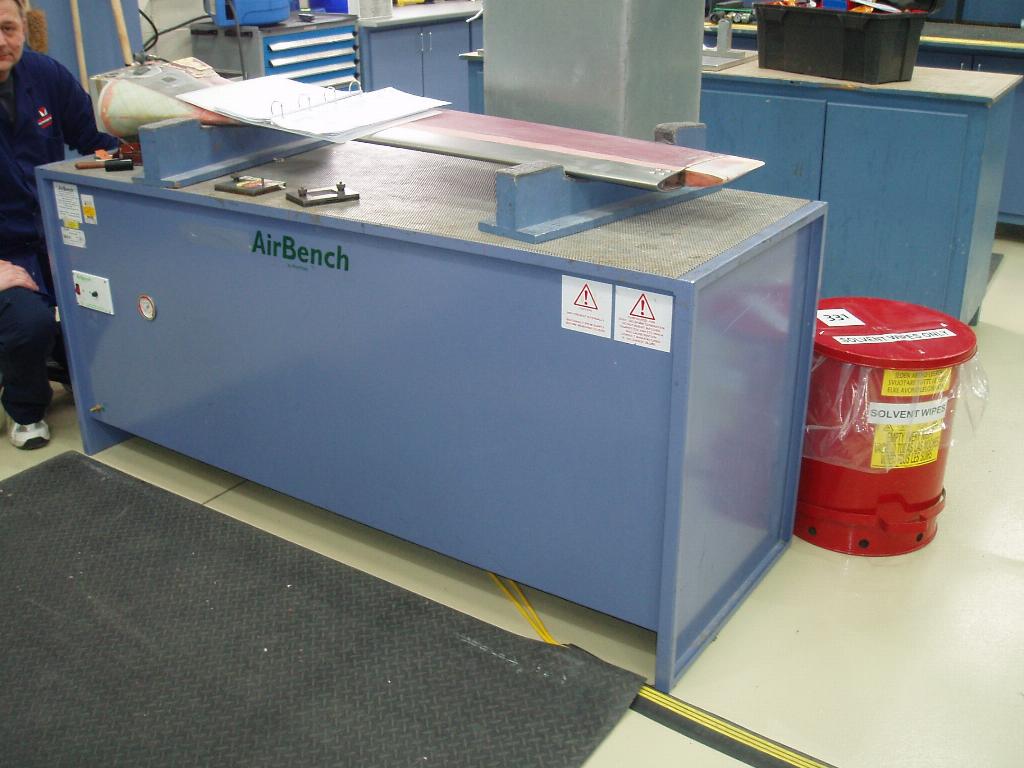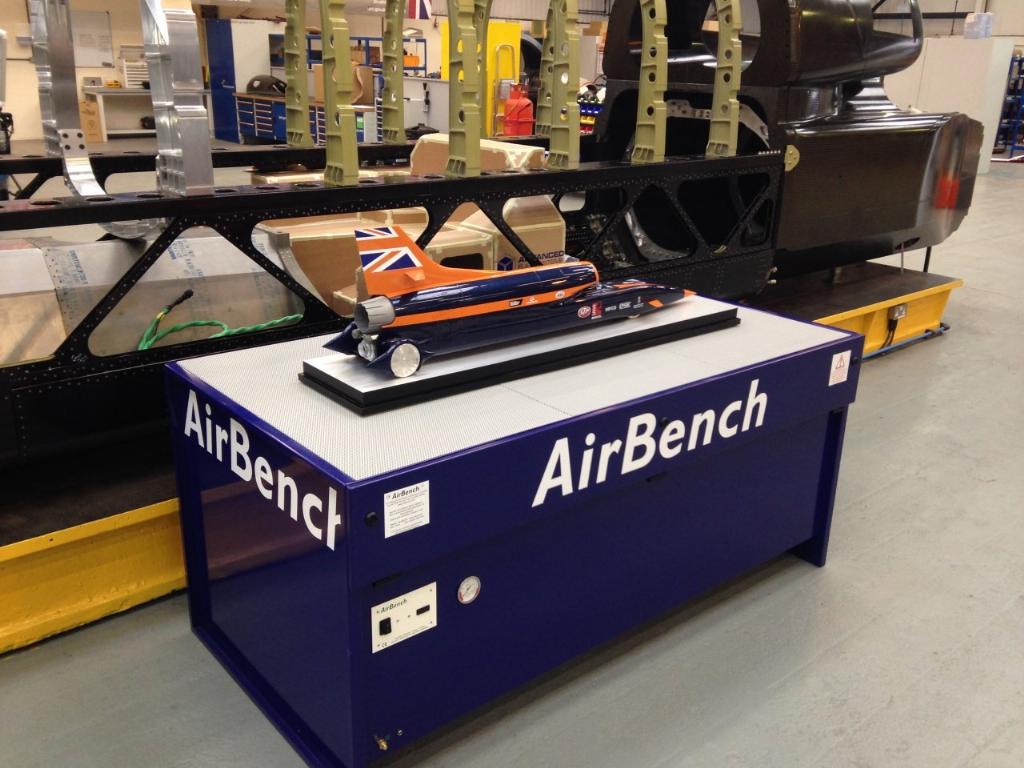Bust the dust

Looking for solutions in dust control? Mike Richardson journeys to dust extraction specialists AirBench’s Colchester, Essex facility to witness its VertEx tower of power being put through its paces.
AirBench used its open week last December to demonstrate the power of its largest VertEx unit, the VA121824. Configured as a large modular walk-in dust extraction booth, the entire system is too big to be transported to customer sites for demonstration purposes, and instead needs to be seen by users face to face to truly understand how effective it can be.
With nearly 10,000 units in service in the UK and overseas, AirBench claims to be the UK’s leading manufacturer of downdraught benches. The company’s dust extraction systems are designed to capture dust and contaminants at source. Integral filters allow air to be recirculated back to the workroom, which means no installation is required and systems remain portable and flexible.
AirBench’s products also ensure a company complies with the latest health and safety obligations, i.e. the Control of Substances Hazardous to Health (COSHH). Indeed, finding an effective, demonstrable dust extraction system can be difficult but it remains important because it can protect both your people and your products from dust.
For example, dust can cause health problems when inhaled, and can also be combustible which can present a potential fire hazard. Equally, many finishing processes are affected by atmospheric dust, so maintaining a clean atmosphere is essential to good spraying, coating and finishing processes.
A tower of strength
But let’s go back to the very origins of the VertEx walk-in dust extraction booth. The original VertEx concept sprang from installations where a standard AirBench had been installed standing on end to solve unusual dust problems, and developed into the basic modular cross-draught system manufactured today. In the next stage of development, AirBench had the novel idea of combining multiple VertEx units with its modular booth panelling system to create a quickly installable, easy to assemble, low energy use, dust extraction booth – and the VertEx modular extraction booth was born!
“Our concept was to design and build a VertEx tower as if it was constructed like Lego bricks,” begins AirBench’s sales manager, Chris Dawson. “This comprises three, 4ft x 2ft open area modules turned on their sides and stacked up on top of each other to create a tower. We can then position another tower next to it, and keep adding more to create a booth as wide as the customer requires.”

AirBench fabricates and builds its bench products onsite and then subcontracts them out to a local supplier for powder coating. The benches are then returned to the company’s cleanroom where they are populated with extraction fan units and filters, and then dispatched to the customer.
“It is our knowledge of how to make air move through a filter at a constant speed, and particularly where the filter provides a wide range of pressures to the fan set that sets us apart from the competition,” states Dawson. “We can specify different filters inside our AirBenches to suit the various applications. The standard base filter is 95% efficient at 5µm. Our products are designed to remove very light dust which can fill up the operator’s breathing zone.”
There is a crucial feature of dust extraction known as the ‘capture zone’. For example, place your hand over a vacuum cleaner nozzle and you’ll feel a lot of suction. What you’re actually feeling is the combined velocity of the pipe. In dust extraction parlance, this is known as ‘ducting’, which can take the form of an extraction arm that can be positioned to hoover up the dust.
“Extraction arms compete with air benches,” notes company managing director, Simon Cook. “An arm can look good and it’s a low-cost option to dust extraction, but by the time you’ve installed it and installed a fan on it, you can often end up spending more money than you normally would for one of our AirBench products. In addition, an arm doesn’t offer the same level of portability as wheeling our bench around the shopfloor. The operator also needs to be trained to ensure that the extraction arm is correctly positioned in the right place.”
The VertEx unit has a pressure gauge on the front that shows the difference between when the filters are clean and dirty. The basic filter in each unit is bonded into the galvanised bench frames, and can be cleaned simply by using a basic vacuum cleaner. The company claims this method is much more affordable and safer than a ‘pulse’ cleaning system.
“We will only specify the most efficient fans inside our AirBenches,” Cook confirms. “The fans specified in a single VertEx unit run at 1.5kW from a single 13A plug socket. A big differentiator is that our units are filtered properly. A typical dust extraction booth will either be hooked up to a large filter system or will simply port the dust to a bin outside. Our units are self-contained, can be quickly installed directly onto the workshop and do not require any major civil engineering-related upheavals to the building, such as drilling large holes into the wall. The standard 2.5m wide VertEx booth moves nearly 20,000 cubic metres of air an hour and can still run from a 13A socket. To obtain this amount from a traditional fan is a very inefficient and expensive way of doing it. Furthermore, 20,000 cubic metres of air an hour is equivalent to using 20 extraction arms.”

A benchmark for success
Many aerospace and motorsport manufacturers now enjoy the benefits of using Airbench’s dust extraction products, particularly in applications where dust generated from materials such as carbon fibre reinforced plastics are an issue.
“We’ve installed our VertEx unit into a company manufacturing carbon fibre race car shells,” Dawson explains. “When it comes to the production of carbon fibre components, we’ve been helping the majority of Formula 1 teams with multiples of our benches, and we have also supplied a number of them with our dust extraction booths too.”
So, if the mountain cannot come to Muhammed, then Muhammed must go to the mountain. Therefore, AirBench will continue to regularly hold open days every six months to demonstrate the VertEx units to prospective customers.
“We sell purely on the benefit of what our dust extraction benches and cross-draught systems can do,” Dawson concludes. “We don’t just focus on discussing price with the customer because when you buy dust extraction systems, you should buy them on the benefit of what it can do and not solely on cost. Buy on price alone, and you’ll end up buying cheap, and cheap just doesn’t work.”











